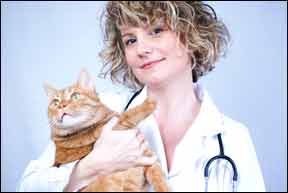As far as you can tell, your nine-year-old cat, Maxine, has never had a sick day in her life. If she has, shes certainly never shown any signs of it. Nevertheless, youve dutifully made a point of taking her to her veterinarian for a routine physical exam twice a year, just to make sure shes up-to-date on her vaccinations and is not 288 harboring any obscure and subtle systemic anomaly that could eventually prove troublesome. Youre doing the right thing, says William Miller, VMD, medical director at Cornell Universitys Companion Animal Hospital, and all cat owners would do well to follow suit. “Its a very good idea to have every cat undergo a twice-yearly exam,” he says. “This is especially true for geriatric cats – those that are age 10 and older – and for animals that spend time outdoors and are exposed to a host of feline diseases.” A thorough checkup should also be obligatory, he advises, for any new cat that is brought into a household and for kittens when they reach one year of age. Owners should know what is involved in a routine examination. They should also know that a standard exam, which could cost in the neighborhood of $100, is, in Dr. Millers words, “a very cost-effective step in preventive medicine.” The routine physical exam will typically include four elements: a medical history of the patient, a physical examination, a complete blood count and a blood serum chemistry panel. In addition, many veterinarians will also do a urinalysis in the routine exam, especially for a geriatric patient. Medical History. A veterinarian will conduct this initial phase of the exam by reviewing the results of a cats previous clinic visits, if available, and by interviewing its owner. The veterinarian will be especially interested in possible signs of illness, such as a noticeable change in an animals eating or drinking patterns or in its elimination activity. “Well want to know what kind of food the cat is eating,” says Dr. Miller, “and if there have been any changes in its litter-box activity. Is it urinating or defecating more often or less often? Is there any change in the texture or color of its feces? Have there been any dramatic changes in its general behavior? The answers to these types of questions can tell you a lot about a cats general health.” Therefore, says Dr. Miller, owners – in anticipation of a routine checkup and the questions that a veterinarian might ask – should regularly monitor their cats activities so that they can serve as accurate “historians.” Physical Exam. In this phase of the exam, the veterinarian – or sometimes a veterinary technician – will check the animals temperature, pulse and respiration. The veterinarian will then give the cat a thorough going-over, from the tip of its nose to the tip of its tail, checking its eyes, ears, nose, teeth, skin and the quality of its hair coat. After listening to the chest with a stethoscope, the veterinarian will manually palpate the cats entire torso and its limbs, feeling by hand for signs of internal disease. “Primarily,” says Dr. Miller, “well be looking for any masses in the abdomen or intestines, any swollen lymph glands, any abnormalities in the limbs or joints, or any other suspicious lumps or bumps.” Complete Blood Count. The chief function of feline blood, like that of human blood, is to carry oxygen and nutrients to the body tissues and to transport carbon dioxide and wastes away from them. It also serves in such processes as cell development, tissue repair and the warding off of infection. Also like human blood, feline blood is made up of red blood cells (erythrocytes), white blood cells (leukocytes), platelets and a colorless fluid (plasma) in which these and other life-supporting blood components – such as hormones, proteins and salts – are suspended. The complete blood count – commonly referred to simply as “CBC” – is a way of determining whether all of these ingredients are present and properly balanced in a cats system. Using about one-twentieth of an ounce of an animals blood, the CBC includes the following major measurements and evaluations: 288 The CBC also measures the protein levels in blood plasma. Low levels of these proteins suggest, for example, the possibility of liver, kidney or gastrointestinal malfunction, while high levels indicate the presence of infection, chronic inflammation or some types of cancer. 

Chemistry Panel. The blood serum chemistry panel focuses on the chemical components suspended in the clear, watery content (serum) of the blood after it has been separated from the cells and from certain proteins that are needed for clotting.
In these tests, the quantity of a dozen or more substances is evaluated in order to assess a wide range of health-determining factors. The chemistry panel can reveal problems in an animals organ function. It can measure the levels of necessary hormones. And it can determine whether the blood is sufficiently rich in electrolytes – chemical compounds that regulate the exchange of necessary electrical charges across cell membranes.
Abnormal (or subnormal) blood levels of various substances may indicate damage or disease involving the kidneys, liver, muscles or glands. For example:
- High levels of alkaline phosphatase may indicate liver damage, while excess blood urea nitrogen (BUN) and creatinine suggest possible kidney dysfunction.
- Elevated amounts of amylase may indicate kidney or pancreatic disease.
- Abnormal calcium levels may indicate the presence of tumors, kidney disease or other disorders.
High levels of blood sugar (glucose) may indicate diabetes.
- Low levels of potassium may explain an animals chronic lethargy or lack of muscle strength.
In addition, a chemistry panel measures total protein, including one called albumin and others known as globulins. High or low blood levels of these proteins can influence many bodily processes, including the ability to retain water and to defend against infection.
Urinalysis. Often done routinely, this test is obligatory when other phases of a routine exam suggest the presence of a kidney or urinary tract disorder. In this test, a sample of a cats urine is assessed for its clarity, color and density. It is tested biochemically to measure the levels of its important ingredients, such as protein and glucose. And it is examined microscopically for the presence of blood cells, bacteria, crystals and other deposits. If, for example, a cat has a bladder infection, says Dr. Miller, “Youll find that theres a lot of pus in the urine.”
A urinalysis is often carried out for cats with urinary abnormalities, such as increased urine production or urination frequency, difficulty in urination or abnormal urine color. The test is also useful in confirming that a cat appearing to be in perfect health is indeed free of any subtle, underlying physical disorders, such as diabetes.
A Speedy Process. An entire physical exam will usually take a half-hour or less, depending on the extent to which the patient is compliant. “The process of getting a blood sample from a cat can range from a piece of cake to all-out warfare,” says Dr. Miller, “so the length of time needed to collect it will vary.
“But assuming that the patient is cooperative, you can do an entire exam, start to finish, in 15 minutes.”



